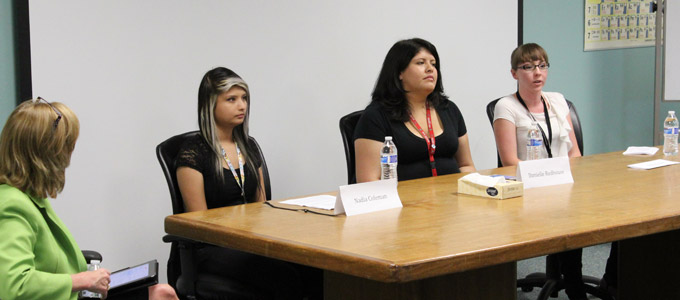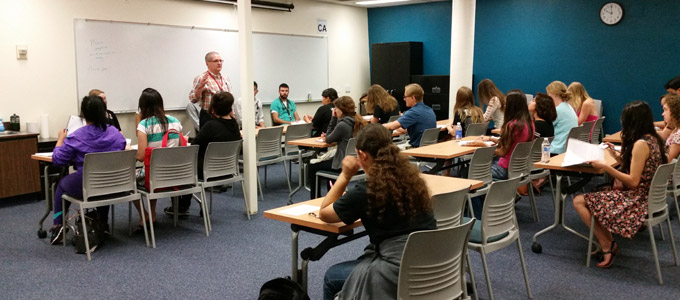Get Involved
Contact Us
MSC05 3040
1 University of New Mexico
Albuquerque, NM 87131
Physical Location:
Education Classrooms
Building 67, Room #211
Phone: (505) 277-0878
stem@unm.edu
MSC05 3040
1 University of New Mexico
Albuquerque, NM 87131
Physical Location:
Education Classrooms
Building 67, Room #211
Phone: (505) 277-0878
stem@unm.edu
STEM University offers free events and projects for UNM undergraduate students to explore different UNM STEM degrees and STEM career options. For a comprehensive look at our events and workshops from 2105-2018, please download our STEM University Snapshot here. Some of our past activities include:
In the Cyanotype and Tintype workshops, students learned about the background and chemical processes of these historical mediums by processing their own photographs.
Students gained field and laboratory experience by collecting snails at the Rio Grande Nature Center and examined, processed and cataloged the sample parasites into the Museum of Southwestern Biology’s Division of Parasites for preservation and for future work.
Students visited the world's first commercial Spaceport in southern New Mexico, where they got an up-close look at the state-of-the-art facility.
Students scanned a carpal bone for a mock forensic case and toured 3D Proven Systems for an up-close look at the 3D printing process.
Participants gained insight into the Army Air Corps 509th Composite Group's role in the deployment of the Fat Man and Little Boy atomic bombs.
Students learned the foundational concepts related to designing smartphone apps by brainstorming app ideas, conducting preliminary market analysis, and identifying the skill sets required to contruct their proposed app.
We invited students to take a break from their hectic week of final exams to enjoy donuts and coffee.
Touring the Intel facility in Rio Rancho, students were exposed to emerging technologies they may also experience in future STEM internships and careers.
Retired physicist Duane Hughes provided insight into the science and history of the Manahattan Project, which led to the creation of the atomic bomb and its detonation at the Trinity Site.
Students developed websites using the WordPress content management system to enable remote access to engineering experiments, including projects using a shake table and sensing technology.
Students visited the Trinity Site, location of the first atomic bomb detonation, to learn about the science and history behind the Manhattan Project.
Students explored the Museum of Southwestern Biology with a guided tour led by Senior Collection Manager Jonathan Dunnum.
This multiple-day event exposed students to the science and technology behind wind and solar energy production, as well as how research in this field is being conducted in New Mexico. Students got a first-hand look at the inside of a wind turbine at the North American Wind Research and Training Center at Mesalands Community College in Tucumcari, New Mexico.
Students visited some of the most prominent geologic formations New Mexico has to offer with Dr. Jason Ricketts. After exploring these active research sites, we camped out for the night and returned to examining more of the fantastic landscape the next day.
Students visited the Rio Grande Nature Valley Center where they identified microorganisms and investigated the impact of the invasive species on the Bosque. Students documented observations in a lab notebook which they later used to synthesize their observations.
Students explored the Sandia Mountains and observed how flora and fauna are impacted by changes in elevation. Students documented observations in a lab notebook which they later used to synthesize their observations.
Students visited Sandia National Laboratories’ Advanced Materials Lab and spoke with a panel of Sandia’s current undergraduate STEM interns. Sandia’s scientists talked about their cutting edge research and took us on tours of their laboratories.

In six one-hour sessions, students learned how to explore medicine as a profession through class discussions and speaking with practicing medical professionals. In addition, students acquired useful tips about developing a strong medical school application.

Students observed birds and other flora and fauna at the Bosque del Apache National Wildlife Refuge. Students documented observations in a lab notebook which they later used to synthesize their observations.
Students traveled to Downtown Albuquerque to speak with resident entrepreneurs at FatPipe and ABQid. Students learned about how their careers have lead them down a successful path to entrepreneurship.
Dr. Trish Henning led us on a behind-the-scenes tour of the Very Large Array in Socorro, New Mexico. Dr. Henning helped students understand how she uses the VLA to map galaxies that are hidden by our own Milky Way galaxy.
Students toured Albuquerque’s Southside Wastewater Reclamation Plant and Water Quality Lab to learn about the vital roles chemists, engineers, and other scientists play in the waste water treatment process.
Students visited the Soda Dam and New Mexico’s 13 mile wide volcanic caldera with Dr. Laura Crossey. We tested the chemical composition of the water and explored the wild terrain carved into the landscape by both volcanic eruptions and water erosion.
Dr. Ana Steffen took us to a prehistoric obsidian quarry in the Valles Caldera National Preserve to discover how anthropologists and archaeologists use the volcanic glass to determine the age of sites, and how volcanic chemistry holds the key to prove where artifacts were made.
Students traveled to the Bosque del Apache National Wildlife Refuge with Dr. Sara Brant to collect hosts for parasites (snails). Students, then, examined and processed the samples to submit them to the Museum of Southwestern Biology's Division of Parasites for preservation. Students completed the same trip and lab work in both June and July to observe how parasites affect their hosts over time.
Students collected microbial samples at El Malpais National Monument’s Four Windows cave. Then, students analyzed their samples in Dr. Northups’ biology laboratory in order to understand what kinds of bacteria survive in such hostile places.
This event exposed students to hands-on activities related to research conducted by UNM’s Center for Water and the Environment (CWE). The Center conducts cutting-edge research into technological and engineering-based solutions to problems with water and the environment experienced by the State of New Mexico and the southwestern United States.
Tech Con is a free technology conference, that offered exposure to various industries and current local research. It was a great opportunity to meet with technology recruiters and professionals.
Students took a tour of the MARHES Lab in the Department of Electrical and Computer Engineering (ECE). There they learned about mobile sensor networks and cooperative control of unmanned robotic vehicles.
The trip to Santa Fe begin with the exhibiton "The Mouse in the Machine" at the Thoma Foundation, followed by a tour of the makers space at Meow Wolf, to see the tools which have made their exhibition possible.
Located at CNM campus, FUSE makerspace and fabrications lab is a community center which provides tools that allow participants to design, prototype, and create manufactured work. On this trip, students learned how to 3D print, laser cut, etch, and silk screen print a t-shirt.
Discover Your Science (DYS) was a festival for students to meet faculty and staff members who can help guide their educational career. The festivals goal was to help students explore different science-related professions, while staying engaged in exciting science-related activities throughout the year.
Students learned the skills of connecting a 3D-360O camera system to a quadcopter drone to produce a short 3D video, at the COSMIAC Research Center. This event included a 1-day field trip to fly quadcopter drone.
A large mixer for all UNM students, staff, faculty and various members of the local Albuquerque science and engineering community. Some activities included AFRL and I AM STEM award winner presentations.
SACNAS Lobos talked to studentsabout interest in biology and biotechnology. They also gave students hands-on experience in extracting DNA from strawberries.
AFRL Scientists lead students on tours of various laboratory facilitates including Satellite Testing, Lasers, High-Powered Microwaves and Optics. Students also learned about internship and scholarship opportunities with AFRL.
An info session and mixer where mentors (AFRL scientists/engineers) were on hand to answer mentees questions (UNM Students). The event took place in the STEM Collaborative Center Classroom.
Students participated in an interactive hands-on 3D printing workshop lead by FUSE Makerspace member Matthew Barbato. They learned the fundamentals of 3D printing including software, equipment, and a live demonstration.
Students participated in an interactive hands-on 3D printing workshop lead by FUSE Makerspace member Matthew Barbato. They learned the fundamentals of 3D printing including software, equipment, and a live demonstration.
Sudents got their feet wet as they took an eye-opening trip into the beautiful Valles Caldera National Park. They spent the day discovering the life beneath the flowing waters, and learning the secret lives of rivers.
Students were provided with information about UNM’s Department of Earth & Planetary Sciences, and identified areas of research with lab tours. They were also exposed to the scientific investigation of fossils and learned about the history, collection and prepping of fossils.
Students participated in hands-on activities to better understand the composition of meteors and the meteorites, and how they are different from asteroids traveling through space. There were also tours the Meteorite Museum and the Geology Museum with Dr. Steven Simon.
Students were lead on a tour of UNM's Fusion and Plasma Science Laboratory, located in the basement of ECE, to view the Helicon-Cathode (HelCat), a device that supports a wide-range of plasma science experiments.
Students participated in a tour of variuos solar panels on campus, while learning the process of solar power, and how it's utilized by the University.
Students, staff and faculty engaged with Dr. Seepersad about her experiences working on STEM-education initiatives and drew connections to how her lesson’s learned may impact our University.
Discover Your Science (DYS) was a festival for students to meet faculty and staff members who can help guide their educational career. The festivals goal was to help students explore different science-related professions, while staying engaged in exciting science-related activities throughout the year.
A large mixer for all UNM students, staff, faculty and various members of the local Albuquerque science and engineering community.
At this undergraduate resource fair, students connected to undergraduate research opportunities and heard from UNM researchers about studying culture.
STEM Gateway Class trip to El Malpais National Monument, New Mexico USA.
Students participated in a workshop at the STEM Collaborative Center Classroom, to learn the principles of fractals and create their own.
Students will participated in discussions on topics related to academic progress, overcoming challenges and barriers, work-life balance, and identities in STEM.
On a field trip to Chaco Canyon, students explored ancient to contemporary Indigenous design elements.
This award recognizes University of New Mexico undergraduate students for their exceptional campus and community engagement, commitment to personal success, as well as their essential contributions towards strengthening our STEM and research communities at UNM.
Students participated in this a hands-on solar panel workshop.
STEM professionals and students shared insights about how they pursued their diverse positions of influence in STEM, strategies for overcoming academic and professional challenges, finding mentors, and pathways for becoming leaders in STEM.
Students took a tour of the Tamarind Institute, a fine art lithography workshop and gallery, led by featured visiting artist Matthew Shlian.
At this workshop for students, by students, attendees listened and discussed the many aspects of being a STEM major.
A large mixer for all UNM students, staff, faculty and various members of the local Albuquerque science and engineering community.
On this trip to the Sevilleta National Wildlife Refuge, students learned about the UNM Biology Department’s Sevilleta Long Term Ecological Research Program.
Students increased their understanding of research, analysis and processes at UNM’s Center for Stable Isotopes lab.
Students discovered the power of nanoparticles, and they can affect light and color.
At this workshop, students designed and prototyped their own ideas for building better aortic heart valves.
In this workshop, analysis of stable isotopes in student’s hair and fingernails identified what their diet is comprised of.
Students worked with Arduino boards to build a spaceship launch simulator device using buttons and LEDs, and were introduced to programming.